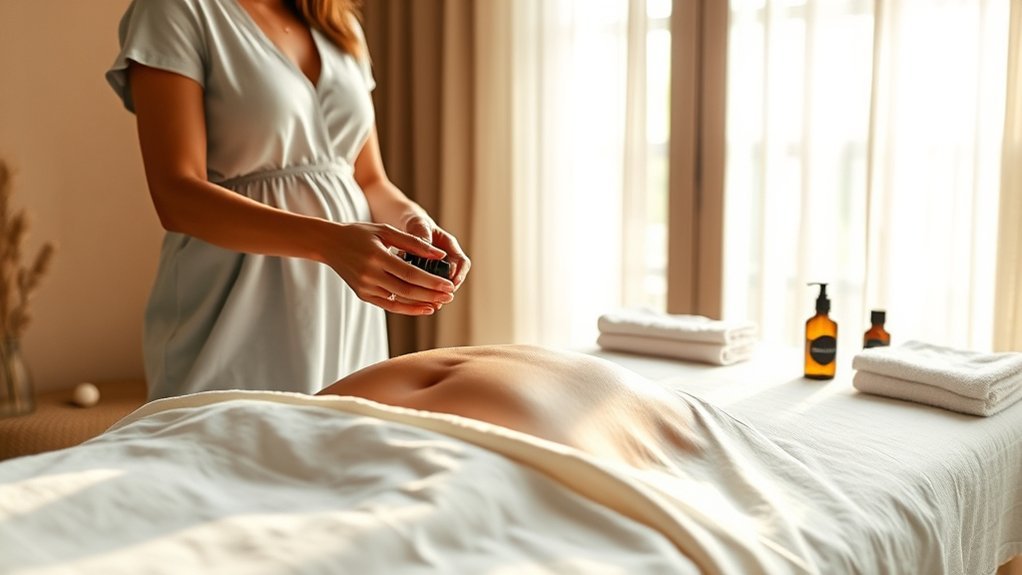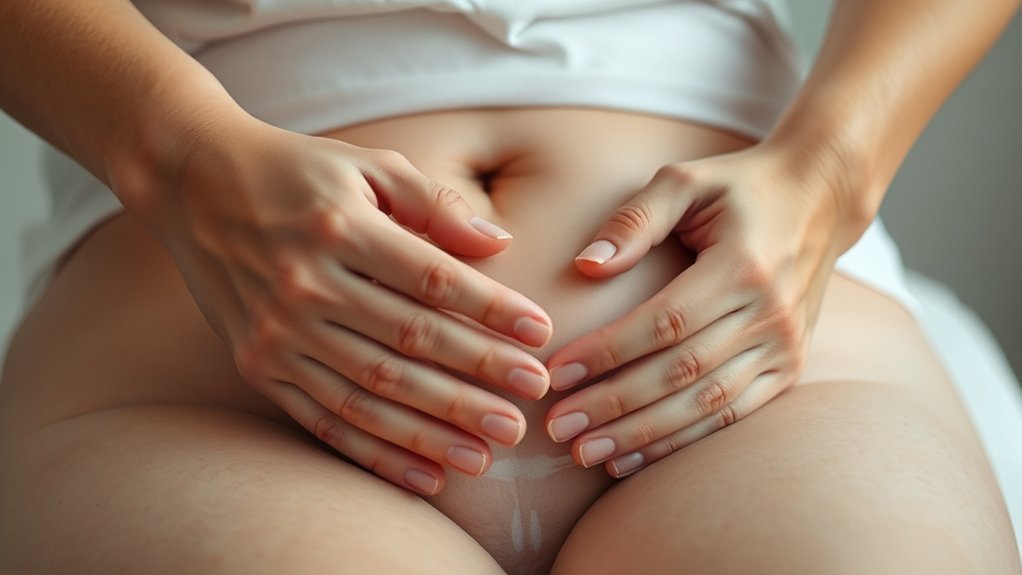Like a well-prepared athlete before a big game, expectant mothers often seek ways to minimize risks during childbirth. Perineal massage has surfaced as a method potentially reducing perineal tearing, but its effectiveness varies widely. Understanding the causes and risk factors associated with this practice is essential for informed decision-making. What should you consider before initiating this journey?
Understanding Perineal Massage

While you mightn’t have heard much about it, understanding perineal massage is essential for many expecting parents.
Perineal massage involves stretching and massaging the perineum, the area between the vagina and the anus, to prepare for childbirth. Research indicates that this practice may help reduce the risk of perineal tearing during delivery and potentially lower the need for episiotomies.
Perineal massage can reduce the risk of tearing and minimize the need for episiotomies during childbirth.
It’s typically recommended to start around the 34th week of pregnancy, using a gentle technique with clean hands or a lubricant. Evidence suggests that regular practice can enhance elasticity and promote relaxation, which may contribute to a more positive birthing experience.
Educating yourself about perineal massage can empower you to make informed decisions regarding your childbirth preparation.
Historical Context and Cultural Perspectives

Perineal massage isn’t just a modern technique; its roots can be traced back through various cultures and historical practices.
In ancient Egypt, midwives utilized similar methods to prepare women for childbirth, emphasizing the importance of flexibility in the perineal area.
Traditional Chinese medicine also recognized perineal care, incorporating it into holistic birthing practices.
In many Indigenous cultures, women have shared knowledge about perineal massage as a way to ease labor and enhance recovery.
These historical perspectives highlight a longstanding recognition of the technique’s potential benefits, often passed down through generations.
Understanding this cultural heritage can enrich your appreciation of perineal massage, emphasizing its significance across time and societies.
Benefits of Perineal Massage

Perineal massage can greatly reduce pain during labor by enhancing tissue elasticity and promoting relaxation.
Additionally, studies suggest that it may improve postpartum recovery by minimizing perineal trauma and associated discomfort.
Understanding these benefits can help you make informed choices about your childbirth experience.
Pain Relief During Labor
Research indicates that perineal massage can greatly enhance pain relief during labor.
This technique not only helps reduce discomfort but also prepares your body for delivery.
Here are some benefits you may experience:
- Decreased tension in the pelvic area
- Increased elasticity of perineal tissues
- Enhanced blood circulation, reducing swelling
- Greater awareness of your body’s sensations
- Improved coping mechanisms during contractions
Improved Recovery Postpartum
While many new mothers focus on immediate care for their newborns, attention to postpartum recovery is equally important. Engaging in perineal massage can greatly enhance your recovery process.
Studies indicate that regular perineal massage before and after delivery may reduce perineal trauma, leading to fewer lacerations and less severe pain. This practice can improve blood circulation, promoting faster healing of tissues.
Additionally, perineal massage may help alleviate discomfort associated with swelling or inflammation, allowing you to regain mobility sooner. By incorporating this technique, you might experience a smoother postpartum change, enhancing your overall well-being.
Ultimately, prioritizing your recovery through perineal massage can foster a more positive experience during this transformative time in your life.
Factors Influencing the Effectiveness
Several factors can influence the effectiveness of perineal massage during pregnancy, impacting outcomes for both the mother and baby. Understanding these factors can help you optimize the practice:
- Frequency of massage: Regular sessions can enhance elasticity and reduce tearing.
- Duration of massage: Longer sessions may lead to better results regarding tissue preparation.
- Technique used: Proper techniques guarantee that pressure is applied correctly, maximizing benefits.
- Maternal comfort level: Feeling relaxed allows for better muscle response and effectiveness.
- Gestational age: Starting earlier in pregnancy can lead to more significant improvements in perineal tissue.
Potential Risks and Complications
Although perineal massage can offer benefits, it’s important to be aware of potential risks and complications associated with the practice.
You might experience discomfort or pain during or after the massage, which can deter you from future attempts. There’s also a risk of infection if proper hygiene isn’t maintained, as bacteria can be introduced into sensitive areas.
Additionally, if you have certain medical conditions, such as a history of pelvic floor disorders, you could exacerbate existing issues. In rare cases, excessive pressure may lead to tearing or bruising of the perineum.
Always consult a healthcare professional before starting perineal massage to verify it’s safe and appropriate for your individual situation.
Guidelines From Healthcare Professionals
When considering perineal massage, it’s essential to follow recommended techniques to guarantee effectiveness and safety.
Healthcare professionals suggest specific timing and frequency guidelines to optimize benefits while minimizing risks.
Recommended Techniques for Massage
Healthcare professionals recommend specific techniques for perineal massage to enhance comfort and effectiveness.
Utilizing the right approach can greatly improve outcomes. Here are some recommended techniques:
- Use lubricant: Apply a water-based lubricant to minimize friction.
- Warm your hands: Make sure your hands are warm to promote relaxation.
- Start gently: Begin with light pressure, gradually increasing as tolerated.
- Incorporate breathing: Encourage deep, slow breaths to help reduce tension.
- Focus on the perineum: Gently stretch and massage the area, moving in circular motions.
Timing and Frequency Guidelines
To maximize the benefits of perineal massage, understanding the timing and frequency guidelines is important.
Healthcare professionals recommend starting perineal massage around 34 weeks of pregnancy. Engaging in this practice three to four times a week can enhance elasticity and reduce the risk of tearing during delivery.
Each session should last about 5 to 10 minutes, allowing ample time for effective stretching. Consistency is key; consequently, incorporating these sessions into your routine will yield better results.
If you’re unsure about your technique or comfort level, consult your healthcare provider for tailored advice. Following these guidelines can help prepare your perineum for childbirth, ultimately promoting a smoother delivery experience.
Techniques for Performing Perineal Massage
While perineal massage can greatly benefit childbirth preparation, understanding the proper techniques is essential for effective practice.
To perform perineal massage correctly, follow these guidelines:
- Choose a comfortable position: Sit or lie down in a way that allows easy access to the perineum.
- Use clean hands: Wash your hands thoroughly to minimize the risk of infection.
- Apply a lubricant: Use a water-based gel or oil for smooth movement and to reduce friction.
- Gently stretch: Insert your fingers about an inch into the vagina, pressing down and towards the rectum while applying gentle pressure.
- Massage in circular motions: Move your fingers in a circular pattern to promote relaxation and elasticity.
Practicing these techniques can enhance your comfort and confidence during labor.
Timing and Frequency Recommendations
Understanding when and how often to perform perineal massage can greatly influence its effectiveness in preparing for childbirth.
It’s recommended that you start practicing perineal massage around 34 to 36 weeks of pregnancy. This timing allows your body to adapt and benefit from the massage as labor approaches.
Aim to perform the massage three to four times a week, spending about 5 to 10 minutes each session. Consistency is key; regular practice can help increase elasticity and reduce the risk of tearing during delivery.
Always make sure you’re in a comfortable position and use a suitable lubricant to enhance the experience.
Consulting with your healthcare provider can provide additional personalized recommendations based on your specific situation.
Alternative Practices for Birth Preparation
As you prepare for birth, exploring alternative practices can enhance your experience and outcomes.
Perineal massage, alongside other natural techniques, offers potential benefits such as reduced tearing and improved comfort during delivery.
Seeking professional guidance can help you tailor these practices to your specific needs and preferences.
Benefits of Perineal Massage
Perineal massage offers several benefits as an alternative practice for birth preparation, primarily aimed at enhancing comfort during labor and delivery.
By incorporating this technique, you can experience:
- Improved elasticity of the perineum, reducing the risk of tearing.
- Enhanced blood flow to the area, promoting healing and recovery.
- Increased awareness of your body, fostering relaxation and confidence.
- A reduction in the need for episiotomies during delivery.
- Potentially shorter labor duration, contributing to a more positive birth experience.
Research suggests that practicing perineal massage in the weeks leading up to childbirth can markedly enhance your overall birthing experience.
Other Natural Techniques
In addition to perineal massage, several other natural techniques can enhance your birth preparation.
Prenatal yoga is one effective method that promotes flexibility and relaxation, potentially easing labor. Deep breathing exercises can help manage stress and improve oxygen flow during contractions.
Acupressure, which involves applying pressure to specific points on the body, may alleviate discomfort and facilitate labor progression. Additionally, using warm compresses on the lower back can relieve pain during early labor.
Hydration and a balanced diet are essential for maintaining energy levels.
Finally, visualization techniques can foster a positive mindset, contributing to a smoother birthing experience. Incorporating these practices into your routine can empower you and support your body’s natural birthing process.
Professional Guidance Availability
While preparing for birth, seeking professional guidance can enhance your experience and guarantee you’re utilizing the most effective alternative practices.
Health professionals, such as midwives and doulas, can provide valuable insights into various techniques that may support your birthing process.
Consider the following options:
- Perineal massage: Taught by professionals to reduce tearing.
- Breathing exercises: Guided sessions to promote relaxation.
- Acupressure: Techniques to alleviate pain and anxiety.
- Water immersion: Support in utilizing hydrotherapy effectively.
- Yoga and stretching: Tailored routines to improve flexibility and comfort.
Personal Experiences and Testimonials
Many expectant mothers share their personal experiences with perineal massage, highlighting both the benefits and challenges they encountered. Many report feeling more in control during labor, as the massage can reduce anxiety and enhance comfort.
Research indicates that regular practice may decrease the likelihood of perineal tearing, which is a common concern. However, some women find it difficult to maintain a consistent routine, citing discomfort or uncertainty about proper techniques.
While testimonials often underscore positive outcomes, experiences vary widely. It’s essential to approach perineal massage with realistic expectations and seek guidance from healthcare providers.
Frequently Asked Questions
Can Perineal Massage Help With Pelvic Floor Disorders?
Yes, perineal massage can help with pelvic floor disorders by increasing flexibility, reducing tension, and improving blood flow. Regular practice may alleviate discomfort and enhance pelvic floor function, promoting overall pelvic health and wellbeing.
Is Perineal Massage Safe During Pregnancy?
Yes, perineal massage is generally safe during pregnancy. It can help prepare the perineum for childbirth. However, consult your healthcare provider to ascertain it’s appropriate for your specific situation and to discuss any potential risks.
How Does Perineal Massage Differ From Kegel Exercises?
While perineal massage prepares the perineum for childbirth, Kegel exercises strengthen pelvic floor muscles. You’ll find that one focuses on relaxation and stretching, while the other emphasizes contraction and support for bladder control and childbirth.
What Tools Can Assist in Performing Perineal Massage?
To assist in performing perineal massage, consider using lubricants like coconut oil, specialized massage tools designed for pelvic relaxation, or even your fingers, ensuring you maintain hygiene and comfort throughout the process for maximum effectiveness.
Are There Any Contraindications for Perineal Massage?
Yes, there are contraindications for perineal massage, including active infections, certain medical conditions like placenta previa, or a history of pelvic surgery. Always consult your healthcare provider before starting any perineal massage practice to guarantee safety.
Conclusion
Incorporating perineal massage into your routine may greatly reduce the risk of perineal tearing during childbirth, with studies indicating that it can lower the incidence of such tears by up to 50%. However, it is crucial to weigh the potential risks and consult your healthcare provider to confirm it’s appropriate for you. By understanding the techniques and recommendations, you can make informed decisions that enhance your birthing experience and promote better outcomes for both you and your baby.
